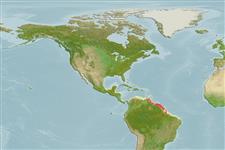Teleostei (teleosts) >
Pleuronectiformes (Flatfishes) >
Achiridae (American soles)
Etymology: Apionichthys: Greek, apion = pear + Greek, ichthys = fish; it also exists "a-pion", no fatty (Ref. 45335).
Eponymy: Auguste Henri André Duméril (1812–1870), was a physician and zoologist like his father (see next entry) and followed much in his father’s footsteps. [...] (Ref. 128868), visit book page.
More on author: Kaup.
Environment: milieu / climate zone / depth range / distribution range
Ecology
Marine; freshwater; brackish; demersal; amphidromous (Ref. 36798). Tropical
Western Atlantic: estuarine areas of the Orinoco (Venezuela), Corantijn (Suriname), Oyapock, Amazon and Grajaú (Brazil) rivers, and from marine areas under influence of these rivers. Enters low land freshwaters - there are records from Jari River (Brazil) and Corantijn River (Suriname).
Size / Weight / Age
Maturity: Lm ? range ? - ? cm
Max length : 13.1 cm TL male/unsexed; (Ref. 80009); common length : 11.0 cm TL male/unsexed; (Ref. 5217)
Dorsal spines (total): 0; Dorsal soft rays (total): 57 - 75; Anal spines: 0; Anal soft rays: 40 - 55; Vertebrae: 34 - 38. Nostril diameter 1.5-2 times orbital diameter; color pattern consisting of a light brown background with irregular, scattered dark brown blotches, the largest ones 2-7 times interorbital space; caudal fin pointed (median rays proportionally longer than external ones); presence of gill openings on both eyed sides; absence of scales on the interorbital space (Ref. 49504).
Rare. Adults occur over sandy-muddy bottoms of the littoral zone and estuaries. Little is known of its biology (Ref. 35237). Maximum length reported to reach 15 cm TL (Ref. 5217).
Life cycle and mating behavior
Maturity | Reproduction | Spawning | Eggs | Fecundity | Larvae
Ramos, R.T.C., 2003. Systematic review of Apionichthys (Pleuronectiformes: Achiridae), with description of four new species. Ichthyol. Explor. Freshwat. 14(2):97-126. (Ref. 49504)
IUCN Red List Status (Ref. 130435: Version 2024-1)
Threat to humans
Harmless
Human uses
Fisheries: commercial; aquarium: commercial
Tools
Special reports
Download XML
Internet sources
Estimates based on models
Preferred temperature (Ref.
123201): 26.9 - 28.1, mean 27.5 °C (based on 102 cells).
Phylogenetic diversity index (Ref.
82804): PD
50 = 0.5078 [Uniqueness, from 0.5 = low to 2.0 = high].
Bayesian length-weight: a=0.00417 (0.00168 - 0.01037), b=3.10 (2.88 - 3.32), in cm total length, based on LWR estimates for this (Sub)family-body shape (Ref.
93245).
Trophic level (Ref.
69278): 3.3 ±0.5 se; based on size and trophs of closest relatives
Resilience (Ref.
120179): High, minimum population doubling time less than 15 months (Preliminary K or Fecundity.).
Fishing Vulnerability (Ref.
59153): Low vulnerability (10 of 100).
